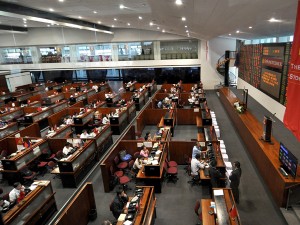MANILA, Philippines–The Philippine domestic economy will likely grow by at least 6.5 percent in the fourth quarter, sustaining the pace of expansion in the first nine months, on the back of accelerated infrastructure spending ahead of next year’s elections.
This was according to a joint research by First Metro Investment Corp.-University of Asia, which thus projected full-year 2012 growth at a little below 7 percent.
“With the Philippine economy bucking the trends abroad, supporting our constructive view since the beginning of the year, we are also more sanguine about the near-term and 2013,” said FMIC-UA&P in their joint publication “The Market Call.”
“Although faced by a higher base in fourth quarter 2011, this year’s fourth quarter should be at least as good as the first quarter to third quarter average GDP (gross domestic product) growth of 6.5 percent, since infrastructure spending is going full blast, especially with the May elections in sight. We expect to see a further acceleration in the growth pace in 2013,” the research said.
For the fourth quarter, FMIC-UA&P said there’s still much room to increase government expenditures.
The research also noted a decelerating trend in inflation supported by stable food and slightly easing crude oil prices. “In short, we see 2013 inflation to slide further from the expected 3.2 percent average for this year,” it said.
“As the economic growth has been domestic demand driven, it is impervious to the gloomy world economic outlook,” the research said.
The research also pointed out that the robust rise in local factory output in September, along with stimulus from overseas Filipino remittances, would boost domestic consumption and likely continue the growth momentum. It also noted the rebound in Meralco’s electricity sales in October.
“GDP growth for the year is likely to be only slightly below 7 percent, as the first month of electricity sales in fourth quarter had a 7.8 percent climb, indicative of another streak of strong gains in the last quarter this year,” the research said.
On export growth, the research while the 22.8-percent expansion in September was encouraging, it’s “likely due to exports that got held up in flood-filled August.” It added that the sudden surge in exports to Japan may be indicative of this. “And so we expect fourth quarter export growth to be in the 5-8 percent range. This is not an issue, since GDP growth is largely domestic-demand driven,” the research said.
On the fiscal side, the budget deficit is unlikely to reach P200 billion this year or around 10 percent lower than FMIC-UA&P’s earlier projections, equivalent to around 1.8 percent of GDP versus 2 percent last year.
“We expect a further decline in the deficit percentage in 2013, as tax collections gain traction with a faster moving economy, the approved hike in sin taxes which is expected to generate P33.5 billion, and improved tax administration. It also confirms our earlier projections that the debt-GDP ratio will fall to some 48.8 percent by the end of this year, and likely to be slightly lower in 2013. Thus, by next year, the country will have a lower debt ratio than Thailand (and it was already lower than Malaysia in 2011),” the research said.
On the financial markets, the research said the continuing attractiveness of the domestic stock and bond markets would continue to fuel the appreciation bias on the peso. However, the research believes that BSP would likely cap this “in view of the harmful effects of the appreciation on the real economy.”


